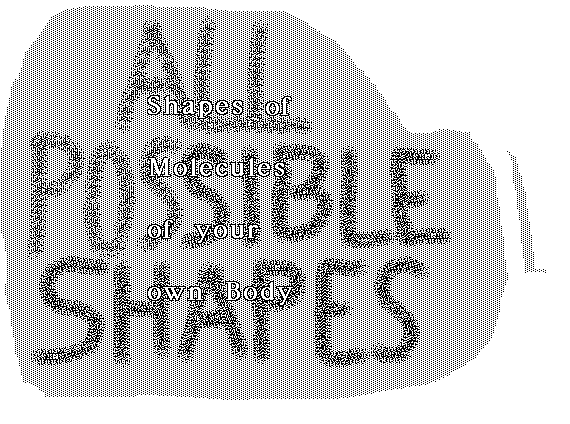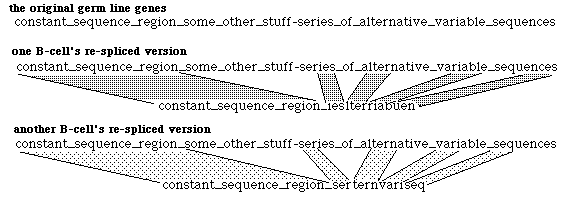March 26, 2007
Embryology Biology 441 Spring 2007 Albert Harris
Embryology of the Immune System
1) Specifically the ability of your B-lymphocytes to make antibodies (antibodies are a certain kind of protein) with binding sites whose shapes exactly fit and bind to germs.
2) And also the ability of your T-lymphocytes to make another (rather similar to antibodies) kind of protein located on the outer surfaces of T-lymphocytes and called "T-cell receptors", which also have binding sites that exactly fit certain peptides, and which serve to stimulate the self-destruction of virus-infected cells.
Any molecule that fits the binding site of an antibody is therefore called an antigen.
 The word antigen comes from the idea that antigens stimulate
the formation of the binding sites of antibodies,
which is only partly true, and can be misleading.
The word antigen comes from the idea that antigens stimulate
the formation of the binding sites of antibodies,
which is only partly true, and can be misleading.
If your antibodies' binding sites don't fit germs, then the germs kill you.
If some of your antibody binding sites fit pollen, or some plastic, etc. the result is called an allergy.
And if you produce antibody or T-cell receptor binding sites that fit any of the thousands of molecules that your own cells & body is made of, the result is an autoimmune disease. (which amounts to a self-allergy).
Autoimmune diseases include Multiple Sclerosis, Lupus, Rheumatoid Arthritis, and dozens of other of the most cruel and life-ruining diseases
Immunity depends on two key embryonic events.
One) The Generator Of Diversity
Which randomly creates the genes for antibody binding sites,
and also the genes for binding sites of T-cell receptors.
 The DNA base sequences for these binding sites are generated
by random recombination of gene fragments & mutations
during each person's embryonic development.
The DNA base sequences for these binding sites are generated
by random recombination of gene fragments & mutations
during each person's embryonic development.
 That's correct!
That's correct!
You do not inherit the genes for antibody binding sites.
Each embryonic B and T lymphocyte generates its own semi-random DNA sequence coding for the amino acid sequences of antibody (etc) binding sites;
& just as often generates anti-self binding sites as anti-germ sites.
Two) The Self-Tolerance Mechanism
Which is essential for getting rid of those B and T lymphocyes
whose randomly-generated binding sites fit "self" molecules.
If the self-tolerance mechanism fails,
then the anti-self B and T lymphocytes attack you.
(= an autoimmune disease.)
*********************************************
*********************************************
*********************************************
*********************************************
*********************************************
*********************************************
*********************************************
*********************************************
*********************************************
*********************************************
*********************************************
*********************************************
*********************************************
*********************************************
*********************************************
??????????????????????????????????????????????????
BRIEF REVIEW OF THE SUBJECT UP TO THIS POINT:
a) Why do we need an immune system?
b) What two differentiated cell types do the attacking?
c) Do they ever attack anything other than germs? 2 examples.
d) An "antigen" is any molecule that is selectively bound to by (what parts of?) proteins called what?
e) Which are made and secreted by what differentiated cells?
f) Virus-infected cells are induced to do what?
g) This is accomplished by what other differentiated cell type?
h) The "Generator of Diversity" accomplishes what?
i) What is unusual about the genes for antibody binding sites?
j) Random DNA splicing also creates what other binding sites?
k) How much did you already learn about immunity in High School, Introductory Biology, or "Cell and Development"?
&&&&&&&&&&&&&&&&&&&&&&&&&&&&&&&
&&&&&&&&&&&&&&&&&&&&&&&&&&&&&&&
&&&&&&&&&&&&&&&&&&&&&&&&&&&&&&&
&&&&&&&&&&&&&&&&&&&&&&&&&&&&&&&
&&&&&&&&&&&&&&&&&&&&&&&&&&&&&&&
&&&&&&&&&&&&&&&&&&&&&&&&&&&&&&&
&&&&&&&&&&&&&&&&&&&&&&&&&&&&&&&
&&&&&&&&&&&&&&&&&&&&&&&&&&&&&&&
&&&&&&&&&&&&&&&&&&&&&&&&&&&&&&&
&&&&&&&&&&&&&&&&&&&&&&&&&&&&&&&
MORE ABOUT EMBRYOLOGY OF IMMUNITY:
* Differentiation of precursor cells to become T-lymphocytes is induced (in Spemann's sense of "induced") by signals they receive when staying in the thymus "gland".
The thymus develops from the second gill slit, and was believed to be vestigial until the 1970s.
Vestigial in the sense of serving no function, but just being left over from our evolution from fish.
Mutations (or early surgery) which prevent formation of the thymus result in failure of T-cells to differentiate.
For some unknown reason, mutations that cause
the thymus not to develop
also cause failure of hair develoment.
("Nude mice" have hardly any T-lymphocytes)
Nobody knows the connection of hair to the thymus!
** Differentiation of B-lymphocytes is induced (again, in Spemann's sense of embryonic induction) by (and also IN) an outpocketing of the intestine called the Bursa of Fabricius, found only in birds.
T is for thymus, although fish don't have them.
B is for Bursa, although only birds have them.
Some other tissue must induce differentiation of B lymhocytes in mammals!? and everybody hopes the name of this tissue must start with a B.
Textbooks confidently claim that bone marrow serves this inductive function, but this is mainly because bone marrow starts with a B, and perhaps is the authors' kindly way to warn you that they are not trustworthy people.
&&&&&&&&&&&&&&&&&&&&&&&&&&&&&
The generation of immune diversity by random splicing and mutation of DNA was one of the most inventive conceptual breakthroughs of 20th century biology. It turned many things upside down.
Jerne, Burnett and Lederberg deserve the credit. (but don't memorize their names for this course)
Lots of biologists still don't get this point. Such people will teach you that the immune system worksby distinguishing self from non-self.
They may even tell you that the purpose of histocompatibility
antigens is as markers to detect "self" molecules.
You have perhaps been taught this?
It contains some truth, but basically is misleading rubbish.
Distinguishing "self" is an effect, not a cause.
Some important evidence is that fused embryos, including even chimeras (mixures of cells from 2 species) do not make immune attacks on any of their tissues.
To me, this disproves any idea of immune tolerance being a matter of cells matching up "self" identification molecules of any kind. It has to be some different kind of mechanism.
There is lots of other evidence.
If you have type O blood, and you got a blood transfusion from someone who has type A blood, but who is otherwise genetically identical in EVERY OTHER GENE (besides the genes for the A blood group antigen) antibodies in your blood would attack the A antigens.
Immune tolerance results from selective elimination (some kind of "weeding-out) of all those lymphocytes in which the random generation of diversity had produced antibody binding sites (or had produced T-cell receptor binding sites) that exactly enough fit any molecule in your body when you were an embryo.
There are even special cells that express many genes just so those proteins can be contacted by embryonic lymphocytes, which can then commit suicide if their binding sites fit any of the proteins being made.
&&&&&&&&&&&&&&&&&&&&&&&&&&&&&
*********************************************
!!!!!!!!!!!!!!!!!!!!!!!!!!!!!!!!!!!!!!!!!!!!!!!!!!!!!!!!!!!!!!!!!!!
@@@@@@@@@@@@@@@@@@@@@@@@
%%%%%%%%%%%%%%%%%%%%%%%%%%
^^^^^^^^^^^^^^^^^^^^^^^^^^^^^^^^^^^^^^^^^^^^^^^
FINALLY FOR TODAY: TWO VOTES ...
Let's vote on which of the following is the oddest fact!
1) That antibody binding site genes are not inherited.
2) That these genes are generated by random DNA splicing.
3) That recovery from viral diseases results from induced suicide of cells holding certain peptides on their surfaces.
4) That the tolerance mechanism works so well that we don't all suffer from dozens of autoimmune diseases.
5) That differentiation of B and T lymphocytes is induced by specific out-pocketings from the endoderm.
5&1/2) That different endodermal out-pocketings are used for this purpose in birds than in mammals, not to mention fish.
6) That autoimmune diseases kill and maim so many million people, without much more research being focused on the mechanism of the self-tolerance mechanism.
7) (Class members will please invent three more questions.)
8)
9)
10)
+++++++++++++++++++++++++++++++++++++++
INVENT WHAT ANIMATION OR COMPUTER SIMULATION OR DIAGRAM, ETC. WOULD MOST HELP YOU VISUALIZE HOW THE IMMUNE SYSTEM WORKS-
Specifically the generation of diversity by random DNA splicing.
Incidentally, the A, B and O blood group substances are chains of sugars (and, yes, there is an O antigen) and all the cells of your body have them, not just red blood cells. So a type O person will reject any graft from type A or B.
Another side issue is that all the cells of your body Also have electrical resting potentials, Not just nerve and muscle cells (and oocytes, of course)
The true mechanism of self-tolerance is selective elimination of all those lymphocytes whose randomly-generated binding sites happen to fit any "self" molecule, based either on those molecules being already present in the early embryo, or being present in large quantities, later.
If you could control this self-tolerance mechanism,
then you could cure all auto-immune diseases.
Plus, it would also be a big help for organ grafting.
Maybe you could even make people non-tolerant to their own "self" cancer cells.
Imagine discovering a simultaneous cure for Lupus, MS etc. etc. etc. !!!!!!
Unfortunately, nobody has quite discovered how the self-tolerance mechanism works, and how to control it, and re-activate it.
TWO MAJOR UNANSWERED QUESTIONS:
Are the "anti-self" lymphocytes killed, induced to die, or inactivated, or isolated on Elba Island, or what?
Is this elimination decided by their antigen being present early enough in the embryo, or by being present in large amounts.